BISAC NAT010000 Ecology
BISAC NAT045050 Ecosystems & Habitats / Coastal Regions & Shorelines
BISAC NAT025000 Ecosystems & Habitats / Oceans & Seas
BISAC NAT045030 Ecosystems & Habitats / Polar Regions
BISAC SCI081000 Earth Sciences / Hydrology
BISAC SCI092000 Global Warming & Climate Change
BISAC SCI020000 Life Sciences / Ecology
BISAC SCI039000 Life Sciences / Marine Biology
BISAC SOC053000 Regional Studies
BISAC TEC060000 Marine & Naval
Storm surges and wind waves are ones of the most important hydrological characteristics, which determine dynamics of the Sea of Azov. Extreme storm surges in Taganrog Bay and flooding in the Don Delta can be formed under the effect of strong western winds. In this work the sea level oscillations and wind waves in the Taganrog Bay were simulated by means of the coupled SWAN+ADCIRC numerical model, taking into account the flooding and drying mechanisms. The calculations were carried out on an unstructured mesh with high resolution. The wind and atmospheric pressure fields for the extreme storm from 20 to 28 of September, 2014 obtained from WRF regional atmospheric model were used as forcing. The analysis of simulation results showed the following. The western and northern parts of the Don Delta were the most flood-prone during the storm. The size of the flooded area of the Don Delta exceeded 50%. Interaction of storm surge and wind wave accelerated the flooding process, increased the size of the flooded area and led to the intensification of wind waves in the upper of Taganrog Bay due to the general rise of the sea level.
the Sea of Azov, storm surge, wind waves, flooding, SWAN, ADCIRC, wetting/drying, parallel computing.
I. INTRODUCTION
Storm surges and wind waves are ones of the most important hydrological characteristics, which determine dynamics of the
In [4], a numerical simulation technology of storm surges and wind waves in the
Characteristics of storm surge and wind waves in the
II. MODEL DESCRIPTION
The coupled model SWAN+ADCIRC integrates two models – SWAN (Simulation Waves Nearshore) [6, 7] and ADCIRC (Advanced Circulation Model for
The ADCIRC model basic equations are defined as follows
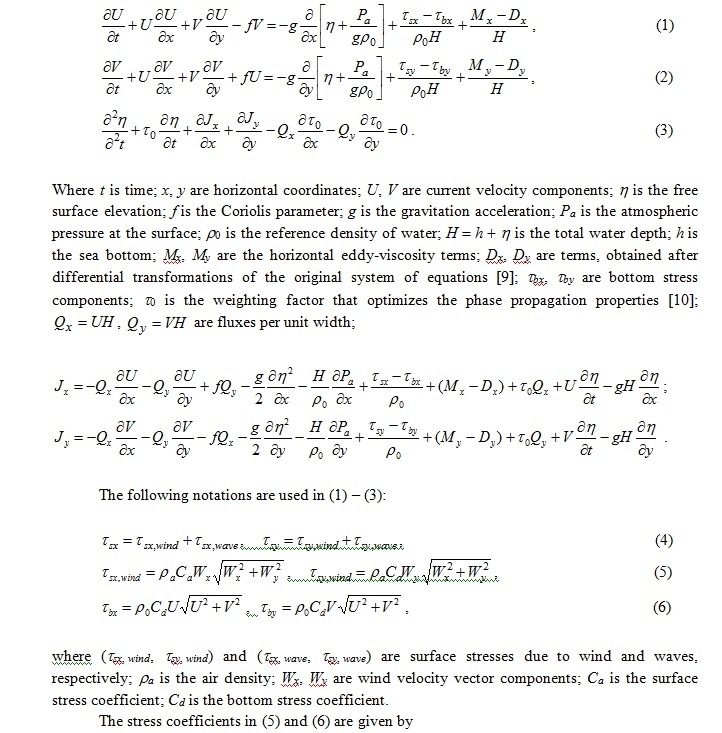
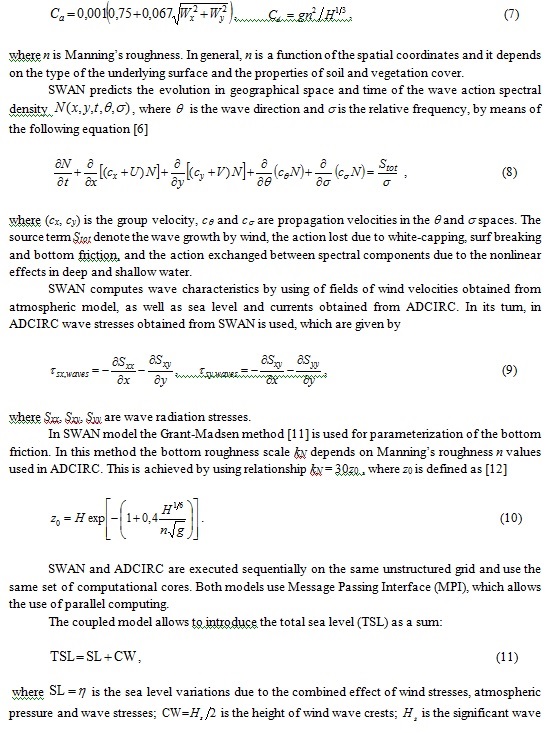

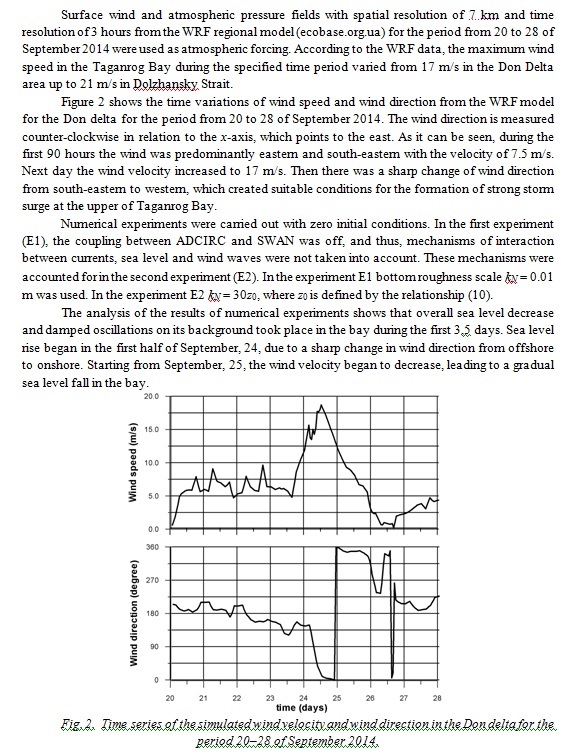


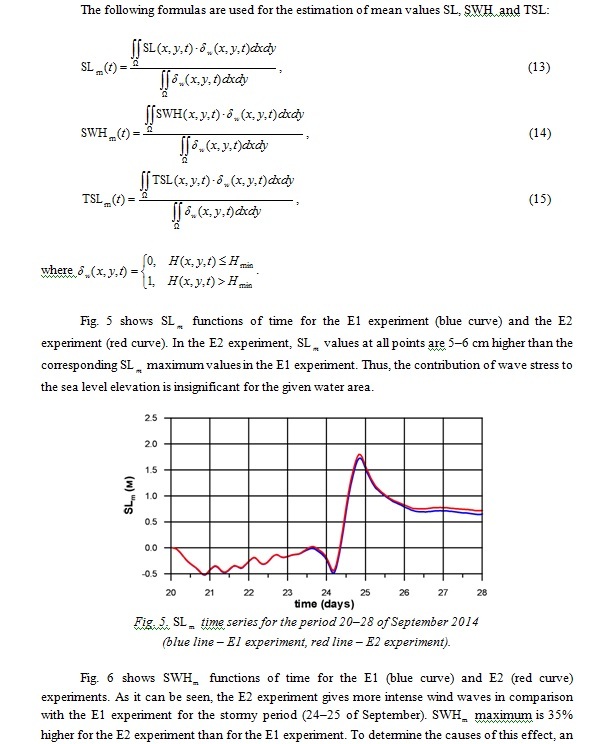
.jpg)
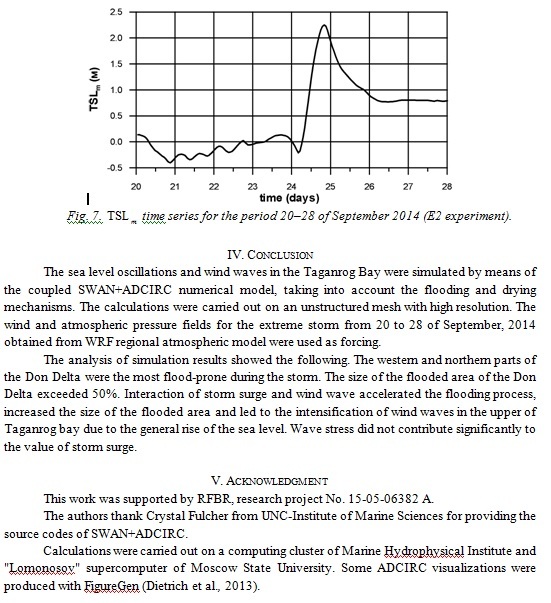
1. V.A. Ivanov, V.V. Fomin, “Mathematical Modelling of Dynamical Processes in the Sea-Land Area”, Kyiv: Akademperiodyka, 2010, 286 p.
2. G.G. Matishov “The Kerch Strait and the Don Delta: the Security of Communications and Population”, Vestnik Yuzhnogo Nauchnogo Tsentra, 11(1), 2015, pp. 6 - 15. (In Russian).
3. G.G. Matishov, A.L. Chikin, S.V. Berdnikov, I.V. Sheverdyaev, A.V. Kleshchenkov et al., “Extreme flooding of the Don Delta in spring 2013: chronology, formation conditions, and consequences”, Vestnik Yuzhnogo Nauchnogo Tsentra, 10(1), 2014. pp. 17-24. (In Russian).
4. V.V. Fomin, A.A. Polozok, R.V Kamyshnikov, “Wave and Storm Surge Modelling for Sea of Azov with use of ADCIRC+SWAN”, Collection of articles of the II International conference «Geoinformation Sciences and Environmental Development: New Approaches, Methods, Technologies», Rostov-on-Don, 2014, pp. 111 - 116.
5. J.C. Dietrich, M. Zijlema, J.J. Westerink, L.H. Holthuijsen , C. Dawson, et al., “Modeling Hurricane Waves and Storm Surge using Integrally-Coupled, Scalable Computations”, Coastal Engineering, vol. 58, No. 1, 2011, pp. 45 - 65.
6. N. Booij, R.C. Ris, L.H. Holthuijsen “A third-generation wave model for coastal regions. Model description and validation”, J. Geophys. Res., 104 (C4), 1999, pр. 7649 - 7666.
7. M. Zijlema, “Computation of wind-wave spectra in coastal waters with SWAN on unstructured grids”, Coastal Engineering, vol. 57, No. 3, 2010, pp. 267 - 277.
8. R.A. Luettich, J.J. Westerink, “Formulation and Numerical Implementation of the 2D/3D ADCIRC”, 2004, URL: http://adcirc.org/adcirc_theory_2004_12_08.pdf.
9. R.A. Luettich, J.J. Westerink, N.W. Scheffner, “ADCIRC: an advanced three-dimensional circulation model for shelves coasts and estuaries, report 1: theory and methodology of ADCIRC-2DDI and ADCIRC-3DL”, Dredging Research Program Technical Report DRP-92-6, U.S. Army Engineers Waterways Experiment Station, Vicksburg, MS, 1992, 137 p.
10. J.H. Atkinson, J.J. Westerink, J.M. Hervouet, “Similarities between the wave equation and the quasi-bubble solutions to the shallow water equations”, International Journal for Numerical Methods in Fluids, vol. 45, 2004, 689-714.
11. W.D. Grant, O.S. Madsen, “Movable bed roughness in unsteady oscillatory flow”, J. Geophys. Res., vol. 87, 1982, pp. 469 - 481.
12. P.C. Kerr, R.C. Martyr, A.S. Donahue, M.E. Hope, J.J. Westerink, et al., “U.S. IOOS coastal and ocean modeling testbed: Evaluation of tide, wave and hurricane surge response sensitivities to mesh resolution and friction in the Gulf of Mexico”, J. Geophys. Res. Oceans, 118, 2013, pp. 4633 - 4661, doihttps://doi.org/10.1002/jgrc.20305.
13. J.C. Dietrich, R.L. Kolar, R.A. Luettich, “Assessment of ADCIRC's Wetting and Drying Algorithm”, Proceedings of the XV International Conference on Computational Methods in Water Resources, vol. 2, 2004, pр. 1767 - 177.







